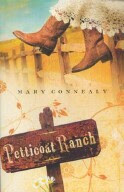by Mary Connealy
What would Gone with the Wind be like if Scarlett and Rhett had gotten along beautifully from the very beginning?
What if Romeo and Juliet had been fixed up by their parents who were close friends?
What if Ariel hadn't been a mermaid wearing a girl suit?
Would we even remember them, would we have kept turning the pages?
Conflict is what hooks a reader and makes the story interesting. If everyone gets along fine, there's no book.
A romance novel needs each character to have two conflicts, an external conflict and an internal conflict. Yes, you can have an "it's us against the world" theme. Yes, you can write a book where the h/h are compatible and work for a common goal, but that's not a romance novel—that’s the Peace Corp. If you want to write within the romance formula, get yourself an external and internal conflict.
External conflict is the easy one for me. External really is only one because it's the story—the plot—the mess you make that you have to clean up. It's what is obviously keeping the two characters apart. It's only one thing, not two. All you've got to remember is; make it insurmountable—the worse the better.
Whatever he has to have—has to destroy her. They can't both get what they want. It's impossible. There, that's conflict.
The classic conflict is: if he's a fireman, she'd better darn well be an arsonist.
Defining your conflict is Step One in writing your novel. What it boils down to is: External Conflict is plot, Internal Conflict is characters.
Continue to part two

 “If they’re sassing each other and falling in love while running for their lives, then I’m happy.”
“If they’re sassing each other and falling in love while running for their lives, then I’m happy.”
Mary Connealy writes books that bring humor to the Wild West. Her next book, Calico Canyon, a sequel to Petticoat Ranch, will be released in August, 2008. Mary lives in northeastern Nebraska, is a teacher married to a farmer, and has four beautiful daughters. To learn more about Mary and her books, visit www.MaryConnealy.com
What would Gone with the Wind be like if Scarlett and Rhett had gotten along beautifully from the very beginning?
What if Romeo and Juliet had been fixed up by their parents who were close friends?
What if Ariel hadn't been a mermaid wearing a girl suit?
Would we even remember them, would we have kept turning the pages?
Conflict is what hooks a reader and makes the story interesting. If everyone gets along fine, there's no book.
A romance novel needs each character to have two conflicts, an external conflict and an internal conflict. Yes, you can have an "it's us against the world" theme. Yes, you can write a book where the h/h are compatible and work for a common goal, but that's not a romance novel—that’s the Peace Corp. If you want to write within the romance formula, get yourself an external and internal conflict.
External conflict is the easy one for me. External really is only one because it's the story—the plot—the mess you make that you have to clean up. It's what is obviously keeping the two characters apart. It's only one thing, not two. All you've got to remember is; make it insurmountable—the worse the better.
Whatever he has to have—has to destroy her. They can't both get what they want. It's impossible. There, that's conflict.
The classic conflict is: if he's a fireman, she'd better darn well be an arsonist.
Defining your conflict is Step One in writing your novel. What it boils down to is: External Conflict is plot, Internal Conflict is characters.
Continue to part two

 “If they’re sassing each other and falling in love while running for their lives, then I’m happy.”
“If they’re sassing each other and falling in love while running for their lives, then I’m happy.”Mary Connealy writes books that bring humor to the Wild West. Her next book, Calico Canyon, a sequel to Petticoat Ranch, will be released in August, 2008. Mary lives in northeastern Nebraska, is a teacher married to a farmer, and has four beautiful daughters. To learn more about Mary and her books, visit www.MaryConnealy.com
Hi, Camy. Wow, I sound so smart!!!!!!!
ReplyDeleteThanks for letting me be on Story Sensei. I just finished Only Uni and I loved it. I can't wait for the next one.